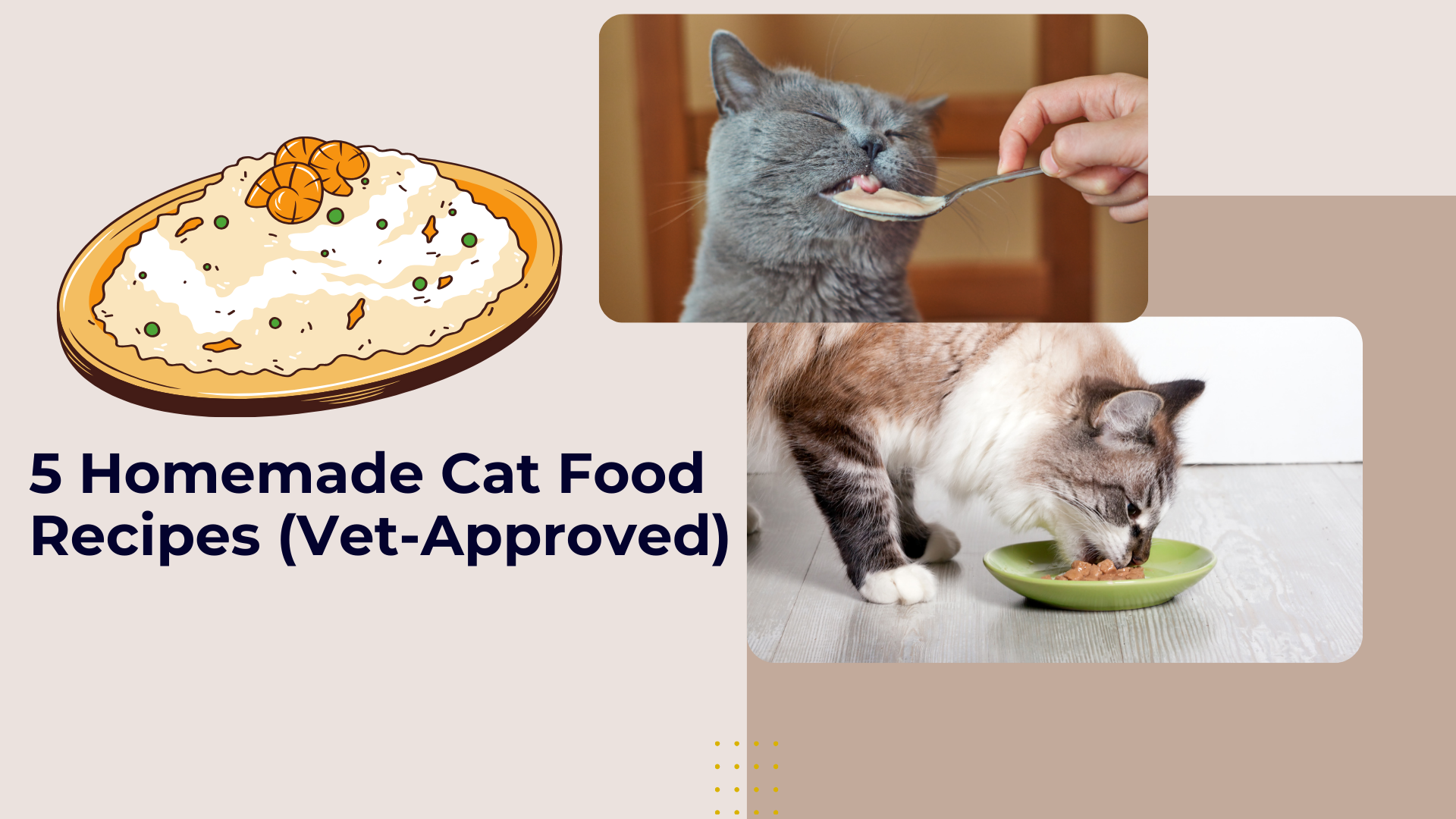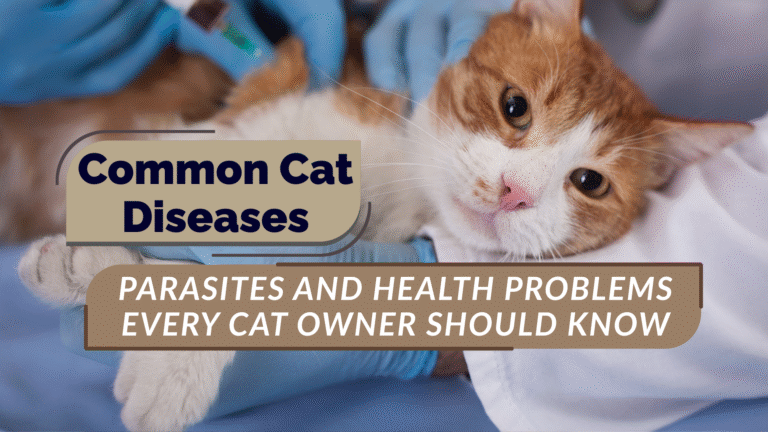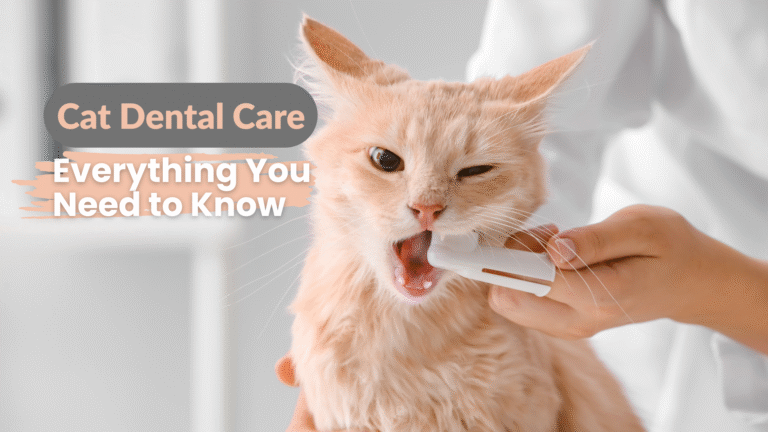5 Homemade Cat Food Recipes (Vet-Approved)
If you’re reading this, chances are you’ve looked at the back of a cat food bag and thought: “Wait… what exactly is all this stuff?” You’re not alone. Many cat parents are moving toward homemade cat food because they want to know exactly what goes into their kitty’s bowl.
There is a caveat, though: cooking for your cat can be wholesome-looking but not necessarily as simple as feeding chicken or rice ahead of them. Cats are obligate carnivores, and their nutritional requirements are highly specialized. Unbalanced feeding would be more detrimental than unbeneficial.
Which is why I’ve compiled this guide: 5 homemade cat food recipes (all of which our vet has approved), along with crucial information on safety, supplements, and can homemade really take the place of store-bought kibble.
Ready to whip up some love for your kitty? Let’s begin.
Why Consider Homemade Cat Food?
There are simply too many reasons pet parents turn to homemade cat food:
-
Transparency: You can see every ingredient in your cat’s bowl.
-
Fewer fillers: No extra grains, additives, or amorphous “meat by-products.”
-
Health concerns: Allergies and sensitivities necessitate individually prepared meals in most instances.
-
Bonding: Don’t pretend preparing meals for your cat is its own love language.
All the same, it’s not a matter of cooking up a scrap soup. A home diet needs to be planned, supplemented, and vetted by an expert.
What Makes a Recipe “Vet-Approved”?
If you look at recipes for cat food that are vet-approved, it is because a vet (usually a veterinary nutritionist) has done the following:
-
Proper protein content (from meat muscle, not garbage).
-
Proper amino acids like taurine (which cats can’t manufacture in sufficient amounts on their own).
-
Proper calcium to phosphorus ratio (usually need to supplement).
-
Proper fat and fatty acids (like omega-3s from salmon oil).
-
Leftover toxic foods (garlic, onions, grapes, and spices).
Expert tip: Talk to your vet first before attempting to introduce any dietary change, especially if your cat has health issues like kidney disease or diabetes.
5 Vet-Approved Homemade Cat Food Recipes
1. Chicken & Pumpkin Bowl
-
Ingredients:
-
1 cup cooked, shredded chicken breast
-
2 tbsp pumpkin puree (not pie filling)
-
½ tsp taurine supplement
-
1 tsp salmon oil
-
-
Why it works: Gentle on picky digestive tracts; digestion aided by pumpkin.
2. Turkey & Rice Comfort Mix
-
Ingredients:
-
1 cup ground turkey (cooked, not flavored)
-
¼ cup brown rice cooked
-
1 tbsp grated carrots
-
½ tsp taurine supplement
-
-
Why it works: Protein-fiber balance for kittens with mild constipation.
3. Fishy Delight
-
Ingredients:
-
1 can of tuna in water (drained) OR ½ cup cooked salmon
-
1 egg yolk cooked hard
-
½ tsp taurine supplement
-
A pinch of cat-safe calcium powder
-
-
Why it works: Great omega-3 supplement; shine coats, joints love it.
4. Beef & Spinach Energy Bowl
-
Ingredients:
-
1 cup cooked lean ground beef (no oil or seasoning)
-
1 tablespoon chopped steamed spinach (no seasoning)
-
½ teaspoon taurine supplement
-
1 teaspoon salmon oil
-
-
Why it works: Energetic cat with high protein and iron.
5. Egg & Sardine Mash
-
Ingredients:
-
1 scrambled egg (no butter, no milk)
-
½ cup water-packed mashed sardines
-
½ teaspoon taurine supplement
-
-
Why it works: Loaded with natural taurine and omega-3s.
Is Homemade Cat Food Safe for Everyday Use?
Short answer: It can, if only balanced.
Homemade cat food is safe to eat daily if:
-
You use recipes with supplements.
-
You omit toxic foods (see below table).
-
You consult your vet regularly for adjustments.
Foods to Avoid in Homemade Cat Food
| Food/Ingredient | Safe for Cats? | Notes |
|---|---|---|
| Onions & Garlic | ❌ No | Can cause anemia. |
| Grapes & Raisins | ❌ No | Toxic to cats. |
| Raw Fish | ⚠ Caution | May carry parasites. Cooked is safer. |
| Cow’s Milk | ⚠ Caution | Many cats are lactose intolerant. |
| Chocolate | ❌ No | Extremely toxic. |
| Bones (cooked) | ❌ No | Can splinter and cause injury. |
Tips for Success with Homemade Cat Food
-
Start slowly: Mix in small amounts with their regular food first.
-
Use supplements: Calcium, taurine, and sometimes multivitamins are required.
-
Cook safely: Avoid the use of oil, butter, and spices.
-
Rotate proteins: Chicken, turkey, fish, and beef preserve food freshness and health.
-
Watch portion sizes: Cats don’t need large meals quality of food, not quantity.
FAQs
1. Is homemade cat food safe for everyday use?
Yes, but only if balanced with the proper nutrients and supplements. Commercial food is already “complete and balanced” by law, so home preparation goes the extra mile to keep up.
2. Do vet-approved cat food recipes always need supplements?
Almost always, yes. Taurine and calcium are must-haves. Cats will be vulnerable to heart and bone disease if they don’t have them.
3. How much homemade cat food should I feed my cat?
Cats typically eat 200–250 calories per day depending on age and activity level. Check with your veterinarian for details.
4. Can kittens eat homemade cat food?
Yes, kittens can, but they need more calories and nutrients. Always talk to your vet first before feeding kittens homemade food.
5. Are homemade cat food recipes cheaper than store-bought?
Occasionally. Cheap bulk meats are affordable, yet supplements are pricey. Real gain is control and quality.
6. What’s the best protein for homemade cat food?
Chicken and turkey are the most easily digested. Fish needs to be occasional due to mercury. Beef is fine in moderation.
Conclusion
Getting your cat to eat can be amazingly fulfilling like sharing love in a bowl. Remember, though, cats are not small people. Their nutrition is special, and balance is the key.
If you’re ready to try homemade cat food, start with one of these vet-approved recipes, introduce it slowly, and talk to your vet about supplements. Your kitty will thank you with extra purrs, shinier fur, and maybe even fewer hairballs.







